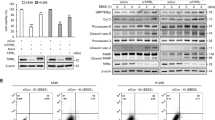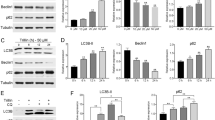Abstract
Previous studies, including those from our laboratory, have demonstrated that isoliquiritigenin (ISL), a flavonoid isolated from licorice, is a promising cancer chemotherapeutic agent. However the mechanisms underlying its anticancer effects are still far from clear. We now show, for the first time, that ISL triggers the mammalian target of rapamycin (mTOR)-dependent autophagic and apoptotic cell death in adenoid cystic carcinoma (ACC). Exposure of both ACC-2 and ACC-M cells to ISL resulted in several specific features for autophagy, including the appearance of membranous vacuoles, formation of acidic vesicular organelles, punctate pattern of LC3 immunostaining, and an increase in autophagic flux. Moreover, ISL treatment also resulted in significantly increased apoptosis in ACC cells. The ISL-mediated autophagic and apoptotic cell death were obviously attenuated by transfection with dominant negative Atg5 (DN-Atg5K130R) plasmids or treatment with 3-methyladenine(3-MA). In additon, the data also revealed that the autophagic and apoptotic cell death induced by ISL occurred through a mTOR-dependent pathway. More importantly, the xenograft model using ACC-M cells provided further evidence of the occurrence of ISL-induced autophagy and apoptosis in vivo, correlating with the suppresson of mTOR activation as well as up-regulation of Atg5 expression. Taken together, these findings in our study suggest that induction of mTOR-dependent autophagic and apoptotic cell death may be an important mechanism in cancer chemotherapy by ISL.






Similar content being viewed by others
References
Chen Z, Liu S, Sumida T, Sun S, Wei Y, Liu M, Dong Z, Zhang F, Hamakawa H, Wei F (2010) Silencing Id-1 with RNA interference inhibits adenoid cystic carcinoma in mice. J Surg Res 169:57–66. doi:10.1016/j.jss.2009.11.723
Dincer N, Tezel GG, Sungur A, Himmetoglu C, Huebner K, Guler G (2010) Study of FHIT and WWOX expression in mucoepidermoid carcinoma and adenoid cystic carcinoma of salivary gland. Oral Oncol 46:195–199. doi:10.1016/j.oraloncology.2009.12.003
Bell D, Roberts D, Kies M, Rao P, Weber RS, El-Naggar AK (2010) Cell type-dependent biomarker expression in adenoid cystic carcinoma: biologic and therapeutic implications. Cancer. doi:10.1002/cncr.25541
Tetsu O, Phuchareon J, Chou A, Cox DP, Eisele DW, Jordan RC (2010) Mutations in the c-Kit gene disrupt mitogen-activated protein kinase signaling during tumor development in adenoid cystic carcinoma of the salivary glands. Neoplasia 12:708–717
Lahiry L, Saha B, Chakraborty J, Bhattacharyya S, Chattopadhyay S, Banerjee S, Choudhuri T, Mandal D, Bhattacharyya A, Sa G, Das T (2008) Contribution of p53-mediated Bax transactivation in theaflavin-induced mammary epithelial carcinoma cell apoptosis. Apoptosis 13:771–781. doi:10.1007/s10495-008-0213-x
Halliwell B (2007) Dietary polyphenols: good, bad, or indifferent for your health? Cardiovasc Res 73:341–347. doi:10.1016/j.cardiores.2006.10.004
Chen G, Zhu L, Liu Y, Zhou Q, Chen H, Yang J (2009) Isoliquiritigenin, a flavonoid from licorice, plays a dual role in regulating gastrointestinal motility in vitro and in vivo. Phytother Res 23:498–506. doi:10.1002/ptr.2660
Sun ZJ, Chen G, Zhang W, Hu X, Huang CF, Wang YF, Jia J, Zhao YF (2010) Mammalian target of rapamycin pathway promotes tumor-induced angiogenesis in adenoid cystic carcinoma: its suppression by isoliquiritigenin through dual activation of c-Jun NH2-terminal kinase and inhibition of extracellular signal-regulated kinase. J Pharmacol Exp Ther 334:500–512. doi:10.1124/jpet.110.167692
Park SJ, Song HY, Youn HS (2009) Suppression of the TRIF-dependent signaling pathway of toll-like receptors by isoliquiritigenin in RAW264.7 macrophages. Mol Cells 28:365–368. doi:10.1007/s10059-009-0130-z
Jung JI, Lim SS, Choi HJ, Cho HJ, Shin HK, Kim EJ, Chung WY, Park KK, Park JH (2006) Isoliquiritigenin induces apoptosis by depolarizing mitochondrial membranes in prostate cancer cells. J Nutr Biochem 17:689–696. doi:10.1016/j.jnutbio.2005.11.006
Kwon GT, Cho HJ, Chung WY, Park KK, Moon A, Park JH (2009) Isoliquiritigenin inhibits migration and invasion of prostate cancer cells: possible mediation by decreased JNK/AP-1 signaling. J Nutr Biochem 20:663–676. doi:10.1016/j.jnutbio.2008.06.005
Yamazaki S, Morita T, Endo H, Hamamoto T, Baba M, Joichi Y, Kaneko S, Okada Y, Okuyama T, Nishino H, Tokue A (2002) Isoliquiritigenin suppresses pulmonary metastasis of mouse renal cell carcinoma. Cancer Lett 183:23–30
Zeng X, Kinsella TJ (2008) Mammalian target of rapamycin and S6 kinase 1 positively regulate 6-thioguanine-induced autophagy. Cancer Res 68:2384–2390. doi:10.1158/0008-5472.CAN-07-6163
Neufeld TP (2010) TOR-dependent control of autophagy: biting the hand that feeds. Curr Opin Cell Biol 22:157–168. doi:10.1016/j.ceb.2009.11.005
Zhao Y, Chen G, Zhang W, Xu N, Zhu JY, Jia J, Sun ZJ, Wang YN, Zhao YF (2011) Autophagy regulates hypoxia-induced osteoclastogenesis through the HIF-1alpha/BNIP3 signaling pathway. J Cell Physiol. doi:10.1002/jcp.22768
Sun ZJ, Chen G, Hu X, Zhang W, Liu Y, Zhu LX, Zhou Q, Zhao YF (2010) Activation of PI3K/Akt/IKK-alpha/NF-kappaB signaling pathway is required for the apoptosis-evasion in human salivary adenoid cystic carcinoma: its inhibition by quercetin. Apoptosis 15:850–863. doi:10.1007/s10495-010-0497-5
Sun ZJ, Chen G, Zhang W, Hu X, Liu Y, Zhou Q, Zhu LX, Zhao YF (2011) Curcumin dually inhibits both mammalian target of rapamycin and nuclear factor-kappaB pathways through a crossed phosphatidylinositol 3-kinase/Akt/IkappaB kinase complex signaling axis in adenoid cystic carcinoma. Mol Pharmacol 79:106–118. doi:10.1124/mol.110.066910
Kusama Y, Sato K, Kimura N, Mitamura J, Ohdaira H, Yoshida K (2009) Comprehensive analysis of expression pattern and promoter regulation of human autophagy-related genes. Apoptosis 14:1165–1175. doi:10.1007/s10495-009-0390-2
Mizushima N, Yamamoto A, Hatano M, Kobayashi Y, Kabeya Y, Suzuki K, Tokuhisa T, Ohsumi Y, Yoshimori T (2001) Dissection of autophagosome formation using Apg5-deficient mouse embryonic stem cells. J Cell Biol 152:657–668
Pyo JO, Jang MH, Kwon YK, Lee HJ, Jun JI, Woo HN, Cho DH, Choi B, Lee H, Kim JH, Mizushima N, Oshumi Y, Jung YK (2005) Essential roles of Atg5 and FADD in autophagic cell death: dissection of autophagic cell death into vacuole formation and cell death. J Biol Chem 280:20722–20729. doi:10.1074/jbc.M413934200
Mizushima N, Sugita H, Yoshimori T, Ohsumi Y (1998) A new protein conjugation system in human. The counterpart of the yeast Apg12p conjugation system essential for autophagy. J Biol Chem 273:33889–33892
Liu WT, Lin CH, Hsiao M, Gean PW (2011) Minocycline inhibits the growth of glioma by inducing autophagy. Autophagy 7:166–175
Nishida Y, Arakawa S, Fujitani K, Yamaguchi H, Mizuta T, Kanaseki T, Komatsu M, Otsu K, Tsujimoto Y, Shimizu S (2009) Discovery of Atg5/Atg7-independent alternative macroautophagy. Nature 461:654–658. doi:10.1038/nature08455
Abedin MJ, Wang D, McDonnell MA, Lehmann U, Kelekar A (2007) Autophagy delays apoptotic death in breast cancer cells following DNA damage. Cell Death Differ 14:500–510. doi:10.1038/sj.cdd.4402039
Hippert MM, O’Toole PS, Thorburn A (2006) Autophagy in cancer: good, bad, or both? Cancer Res 66:9349–9351. doi:10.1158/0008-5472.CAN-06-1597
Pattingre S, Levine B (2006) Bcl-2 inhibition of autophagy: a new route to cancer? Cancer Res 66:2885–2888. doi:10.1158/0008-5472.CAN-05-4412
Gozuacik D, Kimchi A (2004) Autophagy as a cell death and tumor suppressor mechanism. Oncogene 23:2891–2906. doi:10.1038/sj.onc.1207521
Tiwary R, Yu W, Sanders BG, Kline K (2011) alpha-TEA cooperates with MEK or mTOR inhibitors to induce apoptosis via targeting IRS/PI3K pathways. Br J Cancer 104:101–109. doi:10.1038/sj.bjc.6606019
Ladu S, Calvisi DF, Conner EA, Farina M, Factor VM, Thorgeirsson SS (2008) E2F1 inhibits c-Myc-driven apoptosis via PIK3CA/Akt/mTOR and COX-2 in a mouse model of human liver cancer. Gastroenterology 135:1322–1332. doi:10.1053/j.gastro.2008.07.012
Brachmann SM, Hofmann I, Schnell C, Fritsch C, Wee S, Lane H, Wang S, Garcia-Echeverria C, Maira SM (2009) Specific apoptosis induction by the dual PI3K/mTor inhibitor NVP-BEZ235 in HER2 amplified and PIK3CA mutant breast cancer cells. Proc Natl Acad Sci USA 106:22299–22304. doi:10.1073/pnas.0905152106
Annovazzi L, Mellai M, Caldera V, Valente G, Tessitore L, Schiffer D (2009) mTOR, S6 and AKT expression in relation to proliferation and apoptosis/autophagy in glioma. Anticancer Res 29:3087–3094
Wu WK, Sakamoto KM, Milani M, Aldana-Masankgay G, Fan D, Wu K, Lee CW, Cho CH, Yu J, Sung JJ (2010) Macroautophagy modulates cellular response to proteasome inhibitors in cancer therapy. Drug Resist Updat 13:87–92. doi:10.1016/j.drup.2010.04.003
Wong CH, Iskandar KB, Yadav SK, Hirpara JL, Loh T, Pervaiz S (2010) Simultaneous induction of non-canonical autophagy and apoptosis in cancer cells by ROS-dependent ERK and JNK activation. PLoS One 5:e9996. doi:10.1371/journal.pone.0009996
Suzuki K, Ohsumi Y (2007) Molecular machinery of autophagosome formation in yeast, Saccharomyces cerevisiae. FEBS Lett 581:2156–2161. doi:10.1016/j.febslet.2007.01.096
Sudarsanam S, Johnson DE (2010) Functional consequences of mTOR inhibition. Curr Opin Drug Discov Devel 13:31–40
Liu Y, Bassham DC (2010) TOR is a negative regulator of autophagy in Arabidopsis thaliana. PLoS One 5:e11883. doi:10.1371/journal.pone.0011883
Kim KW, Mutter RW, Cao C, Albert JM, Freeman M, Hallahan DE, Lu B (2006) Autophagy for cancer therapy through inhibition of pro-apoptotic proteins and mammalian target of rapamycin signaling. J Biol Chem 281:36883–36890. doi:10.1074/jbc.M607094200
Xiong HY, Guo XL, Bu XX, Zhang SS, Ma NN, Song JR, Hu F, Tao SF, Sun K, Li R, Wu MC, Wei LX (2010) Autophagic cell death induced by 5-FU in Bax or PUMA deficient human colon cancer cell. Cancer Lett 288:68–74. doi:10.1016/j.canlet.2009.06.039
Dikic I, Johansen T, Kirkin V (2010) Selective autophagy in cancer development and therapy. Cancer Res 70:3431–3434. doi:10.1158/0008-5472.CAN-09-4027
Hait WN, Jin S, Yang JM (2006) A matter of life or death (or both): understanding autophagy in cancer. Clin Cancer Res 12:1961–1965. doi:10.1158/1078-0432.CCR-06-0011
Yang Z, Klionsky DJ (2010) Mammalian autophagy: core molecular machinery and signaling regulation. Curr Opin Cell Biol 22:124–131. doi:10.1016/j.ceb.2009.11.014
Savaraj N, You M, Wu C, Wangpaichitr M, Kuo MT, Feun LG (2010) Arginine deprivation, autophagy, apoptosis (AAA) for the treatment of melanoma. Curr Mol Med 10:405–412
Bommareddy A, Hahm ER, Xiao D, Powolny AA, Fisher AL, Jiang Y, Singh SV (2009) Atg5 regulates phenethyl isothiocyanate-induced autophagic and apoptotic cell death in human prostate cancer cells. Cancer Res 69:3704–3712. doi:10.1158/0008-5472.CAN-08-4344
Botti J, Djavaheri-Mergny M, Pilatte Y, Codogno P (2006) Autophagy signaling and the cogwheels of cancer. Autophagy 2:67–73
Yoshimori T (2007) Autophagy: paying Charon’s toll. Cell 128:833–836. doi:10.1016/j.cell.2007.02.023
Hsu YL, Kuo PL, Lin CC (2005) Isoliquiritigenin induces apoptosis and cell cycle arrest through p53-dependent pathway in Hep G2 cells. Life Sci 77:279–292. doi:10.1016/j.lfs.2004.09.047
Acknowledgments
This work was supported by grants from National Natural Science Foundation of China (81072203) to Dr. Z. J. Sun (30801305) to Dr. J. Jia (30973329) to Prof. W. F. Zhang, and (30872894, 30973330) to Prof. Y. F. Zhao. We would like to thank Shelagh Powers in Laboratory of Cell and Developmental Biology, National Institute of Dental and Craniofacial Research for expert editorial assistance.
Conflict of interest
No potential conflicts of interest were disclosed.
Author information
Authors and Affiliations
Corresponding authors
Additional information
Gang Chen and Xiang Hu contributed equally to this article.
Electronic supplementary material
Below is the link to the electronic supplementary material.
Rights and permissions
About this article
Cite this article
Chen, G., Hu, X., Zhang, W. et al. Mammalian target of rapamycin regulates isoliquiritigenin-induced autophagic and apoptotic cell death in adenoid cystic carcinoma cells. Apoptosis 17, 90–101 (2012). https://doi.org/10.1007/s10495-011-0658-1
Published:
Issue Date:
DOI: https://doi.org/10.1007/s10495-011-0658-1




